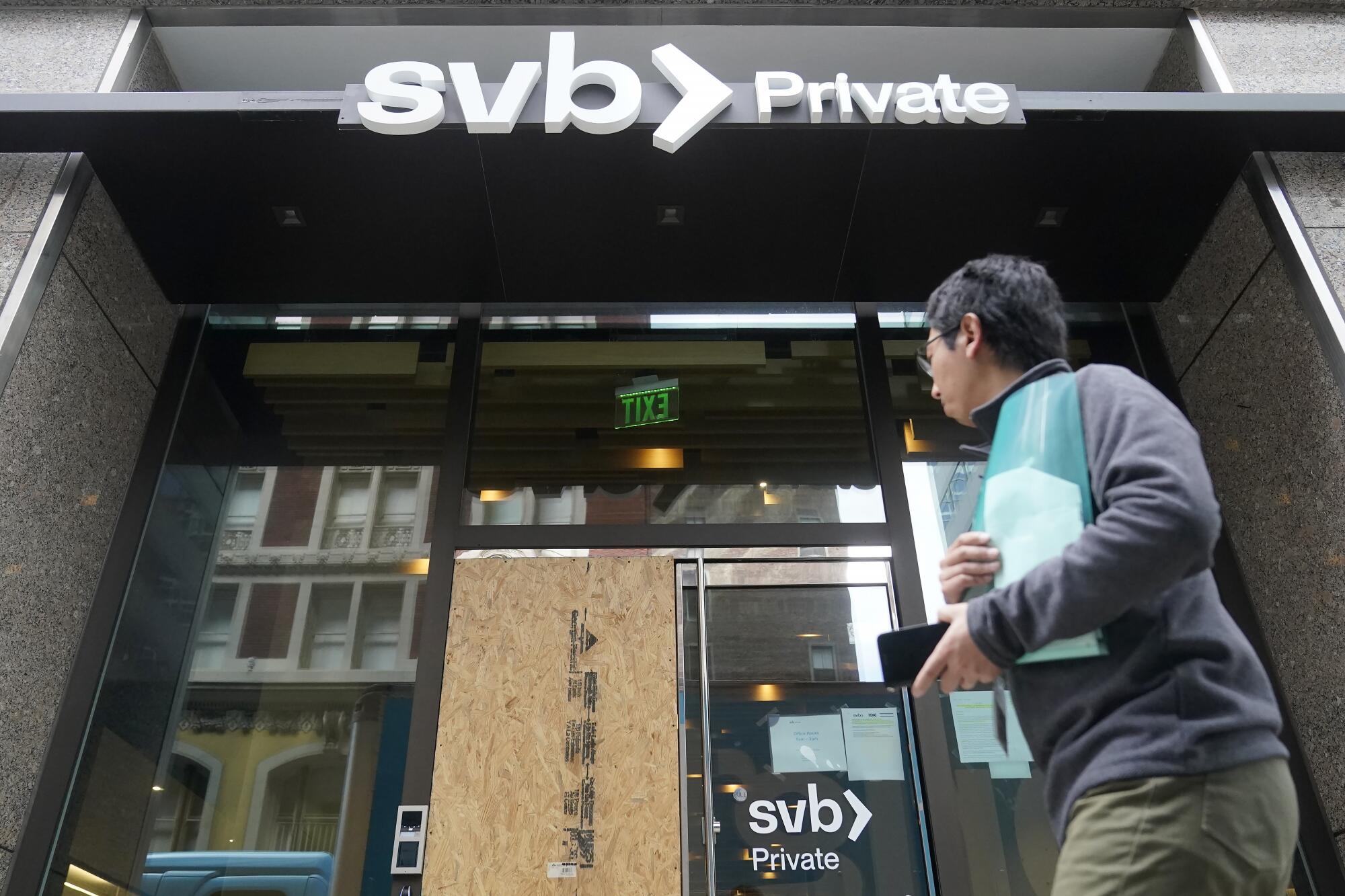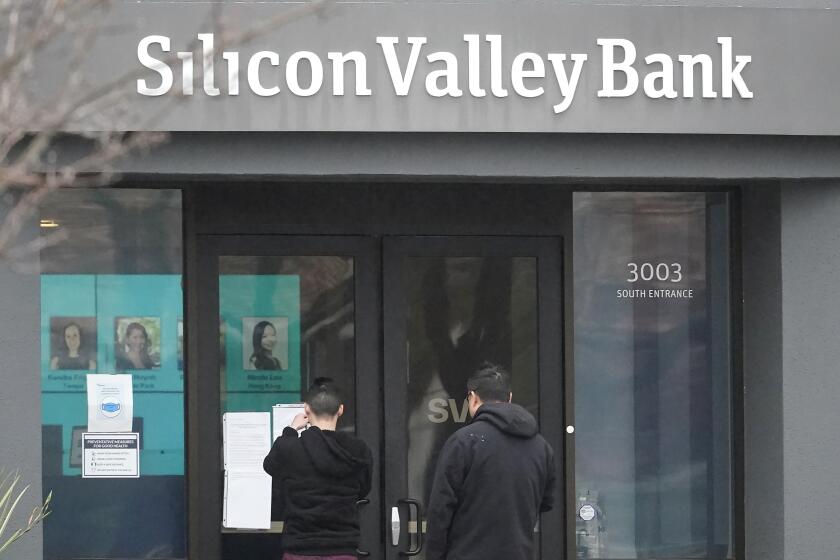
Regional banks say they fill a vital niche not served by bigger banks — and that small businesses and nonprofits depend on their survival
Ure Kretowicz was halfway into his morning routine — coffee, email, a quick walk with his waddly English Bulldog, Brigsby, then hit the exercise bike — when his phone rang.
The call was from a vice president of Torrey Pines Bank, who wanted to reassure Kretowicz that the bank was stable.
“You’re a very valued client,” the banker told him. “I want to bring you up to speed.” They chatted about the bank’s balance sheet “and the fact that there’s nothing to fear here, that it’s business as usual.”
Kretowicz, in turn, was moved to reassure the banker.
This story is for subscribers
We offer subscribers exclusive access to our best journalism.
Thank you for your support.
“I said, look, if you hear me huffing and puffing, it’s not because I’m anxious about this call, it’s because I’m on a spin bike right now,” he said.
Kretowicz is the chairman of Cornerstone Communities, a housing development company that is building single family homes across San Diego County. So a lot of money and — new housing units — are riding on this bank’s health.
The bank failures that jolted the stock market and rattled investors worldwide last week began here on March 8, when Silvergate Bank, a San Diego bank heavily focused on cryptocurrency customers, announced it would liquidate amid mounting losses.
The same day, Silicon Valley Bank of Santa Clara announced it needed to shore up its finances in light of losses from rising interest rates; tech startups responded by pulling deposits en masse, and within a day its stock price plunged 60 percent. By that Friday, the bank had failed.

Investors began dumping shares of other regional and niche banks, and regulators spent the weekend scrambling to stave off a far broader crisis. Signature Bank of New York failed on Sunday. Monday saw shares plunge for such banks as Western Alliance Bancorporation, parent of San Diego-based Torrey Pines Bank, and Zions Bancorporation, parent of locally based California Bank & Trust. The crisis went global, as Credit Suisse issued a warning that it faced “material weaknesses.”
By week’s end, the Federal Reserve has lent out more than $300 billion to banks and several big banks injected $30 billion of deposits to prop up First Republic Bank, another startup-centric institution, to try to soothe its customers. The Swiss central bank lent up to 50 bilion francs, or $54 billion, to Credit Suisse. The rescue efforts seemed to stabilize investors — then Friday saw more selling.
That has left smaller banks like Torrey Pines trying to reassure customers that their niche — specialized care of small business customers — remains viable and essential to a thriving local business sector, from construction to tourism to nonprofits.

Eye on deposits
Edward Carpenter, CEO of Carpenter & Company, an Orange County-based bank launching and funding firm, said he was encouraged that the health of independent small banks would hold up.
“We don’t see a lot of deposits withdrawn from small banks” in the aftermath of the recent bank closures, Carpenter said Wednesday.
It helps, Carpenter said, that most of them are more diversified than Silicon Valley Bank, where fears spread rapidly among a community of similar interests — techies compared notes on Twitter and in group chats — followed by withdrawals. Silicon Valley Bank claimed to provide services to almost half of all tech and life-sciences companies in the U.S.
“Most banks aren’t set up like that,” said Dan Yates, the CEO of Endeavor Bank, a community bank based in San Diego. “Most banks have a well diversified client base and they’re in various sectors.”
Silicon Valley Bank helped make San Diego a good place for startups but with its collapse, now what?
The tech-focused bank, a bedrock piece of the startup community in San Diego and nationwide, was taken over by regulators Friday morning after a run on deposits.
Still, Yates said, the events of the past week have revealed that many banks were overexposed to bonds, and that would have remained a problem if regulators had not stepped in with an array of loans offered to banks looking to rebalance their portfolios.
“Had those tools been in place for other banks, perhaps they’d still be with us, but the reality is they didn’t have that tool to their disposal. Now they do. So many banks this week have elected to borrow against that new facility as opposed to selling bonds and incurring the losses,” Yates said.
Endeavor is not one of them, because it doesn’t have many bonds. Smaller banks, in general, had less exposure to bonds than larger banks, he said.
“Certainly, many of the large regional banks have significant bond portfolios, and I think when you get to the smaller community banks, it varies greatly depending on their business model,” he said.
Independent Community Bankers of America, a trade group of around 5,000 small and mid-sized community banks, put out a statement to that effect, citing FDIC data and saying: “Community banks outperformed the rest of the banking industry during the fourth quarter and had broad-based loan growth, strong capital ratios, and favorable asset quality.”
Bank ranks shrink
The ranks of small and independent banks have shrunk in the last 20 years, as many were bought up by mega-banks like J.P. Morgan Chase, Bank of America and Wells Fargo.
A 2021 article by the Federal Reserve Bank of Kansas City detailed the sector’s constriction.
“The number of community banks, defined as those with assets of less than $10 billion, have declined from just over 8,300 in 2000 to 4,277 as of June 2020,” the article said. It pointed to several factors: geographic deregulation, mergers and acquisitions, bank failures and a decline in new banks.
That trend has played out in San Diego County, local bank industry watchers said.
In the 1970s and 1980s, the county was home to some of the largest banking institutions in California — among them, San Diego Trust & Savings Bank, Southern California First National Bank and Home Federal Savings and Loan.
“All have gone and disappeared,” Carpenter said. In 1985, 45 small banks were headquartered in San Diego County, he said, while today there are eight.
He pointed to one aspect that the Kansas City Fed article also raised: It has become harder to start a bank. In the 1970s, one needed $1 million to do so, while “now the minimum capital is $20 million,” Carpenter said.
The survivors have concentrated even more on services that might get overlooked at larger institutions. Today, while large banks hold about 90 percent of U.S. deposits, Carpenter said, small banks — which he defined as non-regional banks with assets under $1.5 billion in deposits — hold half of small business loans of $1.5 million or less. Most of those, he added, are largely based in “small town America” in the middle of the U.S.
“Why do these banks exist? To lend to small and medium-sized businesses,” Carpenter said.
With that lending comes a different kind of access and familiarity.
“When you’re focused on a region, then the owners of the bank tend to also live and work in that community, they tend to have deep ties to that community that go back generations,” said Yates, at Endeavor Bank. “So generally, the people we’re lending to, we’ve known for quite some time.
“We’re sitting down trying to help our clients solve business problems. Help them grow their top line, make introductions. Those types of things are very valuable to the small and medium sized business owners. And you won’t typically see words like that marketed at the large banks. Not to say they can’t do it or don’t do it. It’s more of a culture of how we do it.”
Pandemic challenges, opportunity
That kind of familiarity served Kretowicz, the residential real estate developer, during the COVID-19 pandemic. When construction came to a temporary standstill, he was making a case to lenders that he wanted “to keep moving forward even though Covid has hit, because we believe that this market is going to do well and we want to keep our concrete guys, our framers and everybody still working.”
While national lenders were guided by national metrics, the smaller, more “nimble” Torrey Pines Bank got his message and worked with him.
“We were fortunate that our regional builders, our regional lenders, were nimble enough to react with us and not overreact because of what’s happening nationally,” he said.
Nearly 7,600 businesses and nonprofits got federal coronavirus aid of $150,000 or more, with a much smaller share receiving loans of as much as $5 million to $10 million
Anne Balcer, senior executive vice president with the Independent Community Bankers of America trade group, said community banks “were able to really shine” through the challenges of the pandemic.
“We saw significant market disruption — loan defaults, issues with credit availability. And community banks were the ones that made the overwhelming majority of the PPP loans” — Small Business Administration-backed loans to sustain payrolls — “and not just to their own customers, but to all those that were in need.”
With this latest crisis still playing out, bankers expressed concern that it will lead to more regulation. Some in Congress blame the bank failures on lax oversight, as well as a move in 2018 to roll back measures put in place after the 2008 financial crisis, including raising the threshold for strict risk tests to banks with at least $250 billion of assets. Critics said problems at Silicon Valley Bank went unaddressed by bank supervisors. President Joe Biden called for tougher penalties on executives of failed banks.
Meanwhile, efforts to assure customers continued. On Friday, as its shares were sliding, Western Alliance — parent of Torrey Pines Bank — issued an update “reaffirming its financial strength.” The bank cited “immediately available liquidity of over $20 billion” as of Thursday and said net outflows, which had accelerated earlier in the week, were back to normal levels and new accounts were being opened.

Staff writers Mike Freeman, Phil Molnar and Natallie Rocha contributed to this report.
Get U-T Business in your inbox on Mondays
Get ready for your week with the week’s top business stories from San Diego and California, in your inbox Monday mornings.
You may occasionally receive promotional content from the San Diego Union-Tribune.

